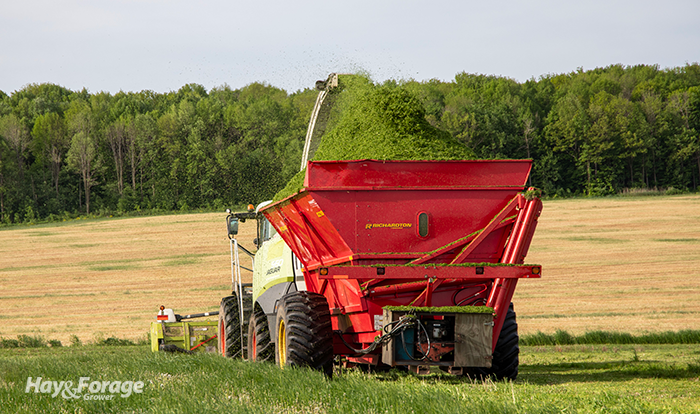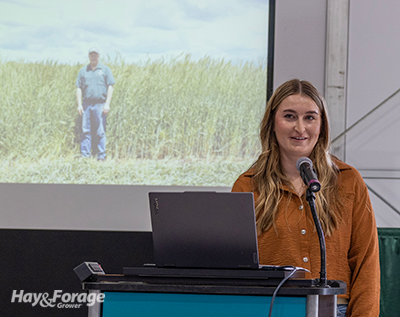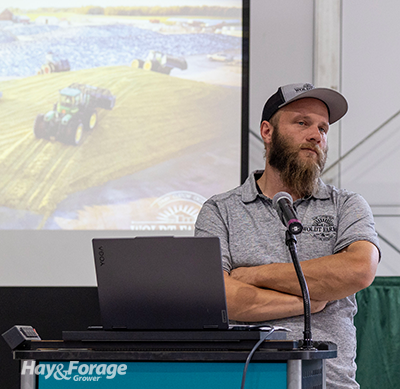
Kelsey Woldt is the oldest of the five daughters who were born and raised on Woldt Farms in Brillion, Wis. Now serving as the farm’s human resources manager, Woldt and her sisters have all been involved on the crop and dairy operation in some capacity over the years. On the Dairy Forage Seminar Stage at last week’s World Dairy Expo in Madison, Wis., she and the farm’s dairy manager, Jeff Evenson, shared how forages are the backbone of their milking program.

The farm got its start when Woldt’s great-great-grandfather started milking cows in 1911. When her parents, Daryl and Amy, took over in 1990, they grew the herd from 80 head to the more than 1,700 cows that reside in the barns today. Woldt Farms also encompasses more than 4,000 acres of owned and rented land used to grow crops for dairy feed.
The Woldts have always utilized perennial grass haylage in their rations, chopping forage and ensiling it in bags. But four years ago, the family started greenchopping some of their grass stands, which turned out to be a game-changer.
“We were looking at ways to cut some ration costs and wanted to give it a try to see if the cows would do well,” Evenson said about getting started with greenchop. And indeed, the cows did. “Every time we’ve started feeding the greenchop, we lose about 2 pounds of dry matter intake per cow, but our components and production stay the same,” Evenson explained. “The cows are eating less but doing the same — or better.”
This year, the Woldts greenchopped about 800 acres of a meadow fescue, tall fescue, and clover mix. They start greenchopping as soon as grass is about a foot tall in the spring, using one of their three self-propelled forage harvesters that is equipped with a direct-cut header. Then, greenchop goes directly into the feed mixer. In addition to the benefits realized at the feedbunk, greenchopping every day allows for continuous manure hauling in the summer.
Greenchop guidance
With that said, Evenson offered a bit of advice for aspiring greenchoppers: The more acres you have available, the better.
“You can protect yourself from different growing conditions you may have,” Evenson said about overestimating greenchop acreage. “Last year it was pretty wet, so there were certain fields that we couldn’t get in because it was raining every day.” But with several fields set aside for greenchop, the Woldts were able to spread their daily needs across different sites that weren’t so saturated.

Having more greenchop acres available can also offset lower yields from drought. “If we hit a dry spell and the grass isn’t growing like it normally does, we have more acreage to pull in so we can keep feeding it,” Evenson said.
For another layer of protection, the Woldts have two rations on the docket — one with greenchop and one without. This way, if the chopper breaks down, rain inhibits harvest, or any other delay occurs, they have a backup plan to feed cows without greenchop until the next crop of fresh forage comes in.
The Woldts started feeding greenchop at a rate of 1.5 pounds of dry matter per head per day, adding more to the ration little by little to determine the optimal feeding rate for their cows and the best harvest schedule for their grass. They eventually hit a sweet spot between 6 to 7 pounds of dry matter per head per day.
“It’s normally 18% to 20% dry matter, so cows eat a lot,” Evenson said. Because of the moisture content, they have a leachate pit at the end of their feed pen to collect runoff, which is applied back to grass immediately after harvest.
Feeding dry cows and heifers
Cover crops have been another important source of dairy feed — and manure hauling — at Woldt Farms, which the family started growing about five years ago.
“In 2020, we really hit the ground running with cover crops,” Woldt said. “We kind of dabbled in it before, but 2019 was such a wet year that we knew something had to change.” Now, almost every acre of Woldt Farms is seeded to cover crops each year. They also practice no-till and green planting on most of their land.
The Woldts seed cover crops in the fall and chop them the following spring for heifer and dry cow feed. Their cover crop mixes change from year to year, but this fall, they are planting wheat, cereal rye, and barley. Chopped cover crops are stored in silage bags.
“The cover crops allow us to get manure out in the fall,” Woldt added. They apply manure on cover crop acres in the spring as well.
In addition to cover crops, the Woldts chop roughly 600 acres of alfalfa-grass haylage, and a large percentage of their dairy rations include brown midrib (BMR) corn silage, which comprises the rest of their cropping acres. Since they usually produce more forage than their cows need, they sell and truck the excess feed to other farmers in the area.
Getting started with soybeans
A more recent development in the Woldts’ feedbunks and crop fields was the addition of high-oleic soybeans. They started growing soybeans this year in effort to replace the commercial fat ingredients that were previously incorporated in their dairy rations and to produce more of their own protein on-site.
Feeding greenchop and oleic soybeans together for the first time this spring, Evenson said cows are consuming about 4.5 pounds less feed per day, but milk production was up 2 pounds per head. Average butterfat also improved 0.2% to 0.3%. Between better feed efficiency and lower feed costs, the Woldts estimate their production costs have improved 70 to 80 cents per head.
Read more about the cropping and dairy enterprises at Woldt Farms here.
